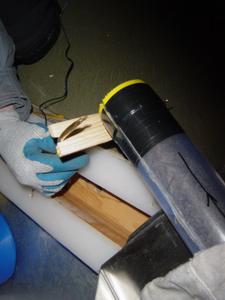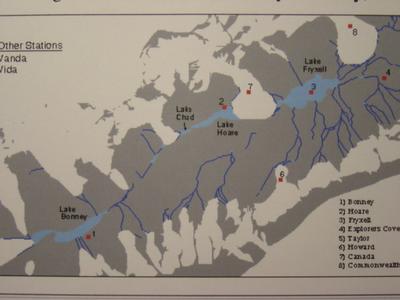6 August, 2003
Next stop: Antarctica!
Today, Phil and I worked on the sediment cores in the walk in
freezer. We tested the effectiveness of using an electric hot knife
and wire for cutting through part of the cores. Both devices may
prove to be useful for certain tasks, but the actual cutting of the
cores will be left to power saws!
The remainder of the day was spent finalizing plans and sorting
through remaining paper work.
The logistics of getting a team to a remote field site in the McMurdo
Dry Valleys of Antarctica are impressive. It is quite a task to
organize travel plans, not only for a group of people, but also for
all the equipment that will be needed in the field. There are
baggage restrictions to follow, customs forms and permits to acquire,
and schedules to coordinate; nothing can be forgotten!
Getting to Antarctica is not an easy task! We will fly from Los
Angeles, California to Auckland, New Zealand. From Auckland, we will
take a thankfully much shorter flight to Christchurch, New Zealand.
If schedules go as planned, we will be in Christchurch for two days.
One day will be for going to the Clothing Distribution Center (CDC)
to get properly outfitted with all the extreme cold weather clothing.
The next day will be scheduled for deployment to Antarctica; but this
depends on the weather! Time spent in Christchurch is ultimately
determined by weather conditions allowing us to leave. The weather in
Antarctica is the larger limiting factor -- are there storms brewing
or occurring? Will the plane be able to land when it gets there?
The plan is for me to leave LA on November 3rd, arriving in
Christchurch on November 5th; that's right, I will lose November 4th
due to traveling across the international date line! November 6th
will be the day I visit the CDC and November 7th is the scheduled day
to depart for Antarctica; we will see!
Once in Antarctica, our team will spend several days in McMurdo
Station. The initial stay in McMurdo will be largely an Antarctic
training session that will include "Happy Camper" school. This
training will teach us how to use the communications radios, how to
build an emergency shelter, and basically how to stay as safe as
possible in the Antarctic environment.
We will then deploy, via helicopter, to the Dry Valleys. We will
spend roughly 7-10 days at Lake Hoare, 7 days at Lake Fryxell, 7-10
days at Lake Bonney, and 1-2 days at Lake Vida. We will be
collecting data, sediment cores, water samples, and will also be
attempting to establish the brine depth under the ice at Lake Vida.
The McMurdo Long Term Ecological Research Project is truly exciting;
I am extremely fortunate to be part of this years field team.
Although there is much still to learn, I feel ready to get underway!
As Apsley Cherry-Garrard (an early Antarctic explorer with Robert
Falcon Scott) said in his book The Worst Journey in The
World: "If you have the desire for knowledge and the power to
give it physical expression, go out and explore." Come out and
explore with us!

1) Slicing through a sediment core with an electric "hot wire."

2) Most commonly used routes to Antarctic locations. (photo from NSF booklet)

3) Taylor Valley Lakes and Monitoring Stations (Diagram from MCMLTER).
Contact the TEA in the field at
.
If you cannot connect through your browser, copy the
TEA's e-mail address in the "To:" line of
your favorite e-mail package.
|
